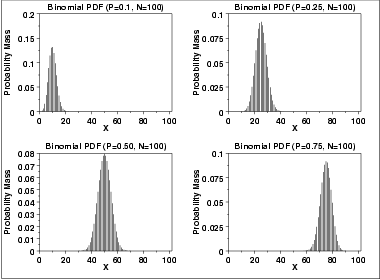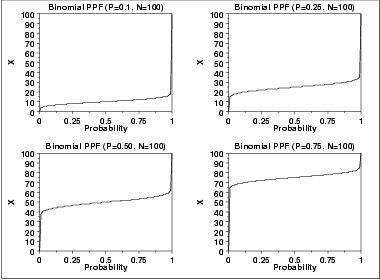1.3. EDA Techniques
1.3.6. Probability Distributions
1.3.6.6. Gallery of Distributions
1.3.6.6.18. |
Binomial Distribution |
The formula for the binomial probability mass function is
\( P(x;p,n) = \left( \begin{array}{c} n \\ x \end{array} \right) (p)^{x}(1 - p)^{(n-x)} \;\;\;\;\;\; \mbox{for $x = 0, 1, 2, \cdots , n$} \)
where
\( \left( \begin{array}{c} n \\ x \end{array} \right) = \frac{n!} {x!(n-x)! } \)
The following is the plot of the binomial probability density function for four values of p and n = 100.

\( F(x;p,n) = \sum_{i=0}^{x}{\left( \begin{array}{c} n \\ i \end{array} \right) (p)^{i}(1 - p)^{(n-i)}} \)
The following is the plot of the binomial cumulative distribution function with the same values of p as the pdf plots above.

The following is the plot of the binomial percent point function with the same values of p as the pdf plots above.

| Mean | np |
| Mode | p(n + 1) - 1 ≤ x ≤ p(n + 1) |
| Range | 0 to n |
| Standard Deviation | \( \sqrt{np(1 - p)} \) |
| Coefficient of Variation | \( \sqrt{\frac{(1-p)} {np}} \) |
| Skewness | \( \frac{(1-2p)} {\sqrt{np(1 - p)}} \) |
| Kurtosis | \( 3 - \frac{6} {n} + \frac{1} {np(1 - p)} \) |
\( \tilde{p} = \frac{x} {n} \)

